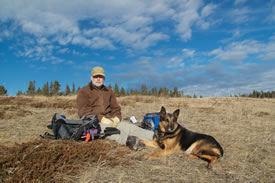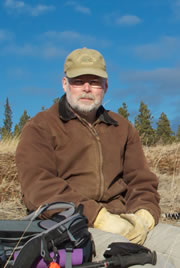A personal prairie legacy: The Tim K. Hodgson Prairie Stewardship Challenge Fund

Tim Hodgson at Horseshoe Dam (Photo courtesy of Tim Hodgson)
Caring for land is personal.
Over 10 years ago, I realized native wildlife habitat conservation was the most meaningful thing to which I could contribute my energy, expertise and time. It was 2003, and I was re-evaluating what I was achieving in a conventional career. I spent months reflecting on how I wanted to spend my life; what I wanted my “second act” to be. I realized during this time of reflection I feel the most at home in the prairies and my concern for these imperiled natural places is great.
As a child, I grew up spending summers between my grandparent's cottage on Lake Wabamun and my other grandparent’s farm on the shores of Lac Ste. Anne, both located in Alberta. Over the years, I traveled through and made home in prairie places. I wandered through Edmonton's ravines, along Winnipeg's railway rights-of-way and across the great native prairies that span these two cities while living as a long-term resident in the rolling grasslands and forests of the Rocky Mountain front near Cochrane, Alberta.
The prairies are like an unplumbed sea whose value is hidden from so many.
I have always thought that so much of the value inherent in prairie landscapes isn’t generally recognized, especially by our predominately urban populations. So many Canadians don’t have the opportunity to experience the plains. But prairies support such a wonderful natural assembly: from threatened songbirds, wildflowers, insects and butterflies to pothole wetlands that play such an important survival role for migrating waterfowl every year. They are places all unto their own.
Our prairie grasslands provide us with water retention and management facilities, at least until drainage patterns are modified to increase short-term arable land and those natural flood buffers are removed. Even the superior nutritional value of native forage (e.g., rough fescue) versus modified forage (e.g., Timothy or smooth brome) comes as a surprise to many.
Realizing how important these landscapes are, I became interested in creative ways of ensuring the long-term care of large-scale prairie lands critical to both Canada's and the world's natural biodiversity. Having organizations like the Nature Conservancy of Canada (NCC) acquire the lands is of limited value if nobody is prepared to step up and look after them. Once gone, bringing healthy prairies back may be all but impossible; especially at the meaningful scales that are so critical for effective conservation.
This interest led me to join NCC to conserve Canada's natural biodiversity. For the first five years I assumed the responsibility of general manager for NCC's Alberta Region and more recently as the national director of conservation operations responsible for ensuring NCC's core conservation activities are in keeping with the organization's mission, policies and procedures. I have now been with NCC for 10 years and am immensely proud of what the organization has achieved.
In August 2012 I was blindsided by a diagnosis of Multiple Myeloma (bone marrow plasma cancer) that has curtailed my activities with NCC. This is an incurable affliction and the genetic variant I am dealing with is particularly aggressive. Consequently I have been on a long-term health leave as my time and energy has been focused dealing with the cancer.
Recently, as I have continued to exhaust the treatment options in my battle with Multiple Myeloma, a group of friends and colleagues from my pre-NCC career got together and created a fund in my name in honour of my medical challenges to support the NCC in the pursuit of its mission. I suspect they may not truly appreciate just how much this incredibly generous and totally unexpected initiative on their part means to an individual in my situation.
The Tim K. Hodgson Prairie Stewardship Challenge Fund supports scientific research, inventories, monitoring, property management and community involvement in prairie habitat restoration on NCC properties in Alberta, Saskatchewan and Manitoba. By growing this fund, I am hopeful we can, together, achieve tremendous results such as halting the drastic decline of prairie songbird populations by ensuring sufficient native habitat survives, or ensuring coming generations have the opportunity to share my experiences in pursuing mallards and sharp-tails on cool fall days, just as I was able to follow in the footsteps of previous generations, or spending summer days fishing for native prairie species.
I am connected by prairie landscapes to my past, including my great-great-grandparents who homesteaded north of present-day Regina before there was such a town or a province called Saskatchewan, and now to the future, as a result of this stewardship challenge fund.
Looking forward, this fund represents a chance to leave a legacy focused on the care and protection of prairie landscapes. Together, we share a great opportunity and a great responsibility to learn more about and care for what remains of one of the world’s most endangered habitats right here at home.
In honour of Tim Hodgson, who has contributed personally and professionally in many ways to the economic development and natural heritage conservation of Canada’s three prairie provinces, his friends, family and colleagues wish to create the TIM K. HODGSON PRAIRIE STEWARDSHIP CHALLENGE FUND at the Nature Conservancy of Canada to support critical conservation work in Alberta, Saskatchewan and Manitoba.
If you would like to make a donation in support of the fund, please call NCC toll-free at 1-800-465-8005 or click here. No matter which giving option you choose, please be sure to indicate (e.g., in the memo portion of your cheque or in the “additional comments” field when donating on-line) that your gift is for the “Tim K. Hodgson Prairie Stewardship Challenge Fund.”


